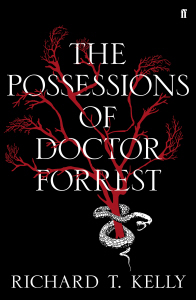 Having rehearsed here the influence on me of a good many of the great and obvious classics of Victorian gothic, I turn a little belatedly to Wilde’s Dorian Gray (1891) – a novel the idea of which I like rather more the work itself, I must confess. As a study of ‘the terrible pleasure of a double life’ it is of course a kind of cousin to Dr Jekyll and Mr Hyde, but very much the junior partner. Not to say there aren’t many elements in it that I enjoy a good deal. Wilde’s very fine, only slightly embellished evocation of the streets and physical facades of central London, their handsomeness turned eerie during the condition of twilight especially; his fairly heady accumulation of fin de siecle aestheticism in the descriptions of decor; the relishable gruesomeness of the passage where Dorian blackmails an old ex-friend to dispose of a corpse on his behalf… Truth be told, the bloodiness of that last passage comes to some extent as a cheering remedy to the chill bloodlessness of all the fancy furnishings, and their famous debt to the A Rebours of J.K. Huysman, a work that amused me a fair bit as a teenager but which I’ve never been able to feel the same about since a visit to Gabriele d’Annunzio’s skin-crawlingly decadent play-palace in Gardone Riviera, gilded turtle and all…
Having rehearsed here the influence on me of a good many of the great and obvious classics of Victorian gothic, I turn a little belatedly to Wilde’s Dorian Gray (1891) – a novel the idea of which I like rather more the work itself, I must confess. As a study of ‘the terrible pleasure of a double life’ it is of course a kind of cousin to Dr Jekyll and Mr Hyde, but very much the junior partner. Not to say there aren’t many elements in it that I enjoy a good deal. Wilde’s very fine, only slightly embellished evocation of the streets and physical facades of central London, their handsomeness turned eerie during the condition of twilight especially; his fairly heady accumulation of fin de siecle aestheticism in the descriptions of decor; the relishable gruesomeness of the passage where Dorian blackmails an old ex-friend to dispose of a corpse on his behalf… Truth be told, the bloodiness of that last passage comes to some extent as a cheering remedy to the chill bloodlessness of all the fancy furnishings, and their famous debt to the A Rebours of J.K. Huysman, a work that amused me a fair bit as a teenager but which I’ve never been able to feel the same about since a visit to Gabriele d’Annunzio’s skin-crawlingly decadent play-palace in Gardone Riviera, gilded turtle and all…
But hark at me. For what reason in Doctor Forrest is Robert Forrest’s romper-room boudoir octagonal? And why does he keep an antique cassone at the foot at his bed? Et cetera…
The recent 2009 movie version of Wilde is a handsome enough piece, and could be taken as one more example of how, given the influence of ‘steampunk’, the Victorian era on film is now almost a byword for a kind of stylised frock-coated fast-cutting dynamism. But the problem with the story is the protagonist – a void, really, partially filled on the page by Wilde arranging words like flowers but on screen neither an engaging anti-hero or a properly menacing villain…
66. Wilde’s ‘Dorian Gray’: Deadly Narcissus
Filed under Uncategorized


